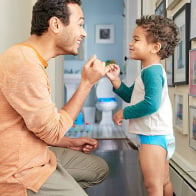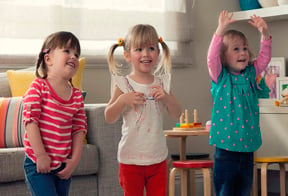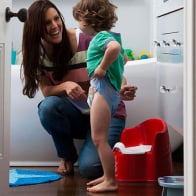Are you ready for the new adventure of potty training your child? While you may experience some bumps on the way, potty training is an exciting journey that will bring you and your child independence.

Recognizing Readiness for Potty Training
According to the American Academy of Pediatrics, by the age of two, you can start paying attention to signs from your child that show physical, emotional, and mental readiness to begin potty training.
Noticing these signs might mean that your little one may be ready:
- Your child can spend two hours or more without wetting their diaper.
- You may notice that a strange look suddenly crosses their face in the middle of an activity as they stop doing it. This may mean that they notice the feeling of needing to poop or pee.
- Your toddler can tell you that they need to use the bathroom
- They may become irritated when wearing a dirty diaper or show that they’re not interested in wearing one.
- Your toddler may also be showing an interest in wearing big kid underwear.
Using Training Pants While Potty Training
Made with ultra soft, allergy friendly materials, these diapers are breathable and help protect sensitive skin while giving your big kid® 100% leakproof protection to help them do what they do best.
Dermatologist approved; these diapers also make changes easier with soft, refastenable sides.
Stick with a Potty Training Routine
If you notice that your toddler often pees or poops at the same time every day, you can leave their diaper off and encourage them to use the potty at these times instead.
But you will need to keep a sharp eye during these times to help avoid accidents.
Use Positive Language
Use Positive Encouragement and Rewards
When you see that your child uses the potty successfully reward them with one of their favorite things to keep the good energy going.
You can even create a potty training sticker chart that allows them to earn a sticker every time they successfully use the potty
Continue this positive encouragement and tell them that they did a good thing by letting you know that they needed to use the bathroom. If they were unable to go or if they do go, this positivity will encourage them to use the potty.
Is There a Difference in Potty Training Readiness for Girls vs Boys?
Because each child is unique, the best way to tell if your child is ready is to check for these signs of readiness and interest in using their potty.
When it comes to potty training your child ask yourself these questions:
- Do they seem ready and excited to start?
- Do they feel comfortable and safe?
- Do they seem interested in wearing big kid underwear?
Tips to Successful Potty Training
- Step 1: Put the potty in an easy to reach place. This will make it easier and reduce the risk of accidents.
- Step 2: Make it fun! By singing or joking while your child is using the potty you make the experience less scary for her and more inviting.
- Step 3: Once your child done, let them know how proud you are and give her a reward. Now would be a good time to pull out that sticker chart.
- Step 4: It's time to wash up. Here you can use your child’s favorite scented soaps or foaming cleanser. This can be another step your child looks forward to .
- Step 5: Take your time. On average it can take up to eight months to potty train a child (although every child is different) so remember not to punish them if they have an accident or don't immediately pick it up.
Potty Training Patience
Regressions
- Your child feels stressed. If they’re going through a change in life like attending a new school, moving to a new neighborhood, or another baby on the way, your little one might feel stressed leading to more accidents. Once they settle into this new phase of their lives, they’ll be back on the potty again.
- They might have a health issue. Your child might be suffering from constipation/painful bowel movements or have a urinary tract infection, if they are experiencing this discomfort, it would cause them to want to avoid sitting on the potty.
- Your child is easily distracted. Children can be quite absorbed in their activities. If your child is playing and so absorbed that they don’t notice the urge to visit the bathroom, they’ll end up having accidents.
Nighttime Accidents
Accidents in Public Happen
Frustration
Successful and Rewarding Potty Training Journey
On this journey, use this guide to find tips, games, products and more to make the potty training journey fun, fast and easy.
CHECK OUT MORE ABOUT OUR LINE OF POTTY TRAIN ESSENTIALS FROM PULL-UPS®











